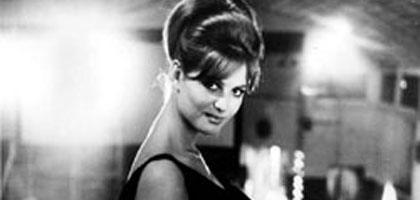
Why Fellini?

A 'maestro' of neorealism in the 60s, Federico Fellini is notorious now for his love of bizarre and sentimental theatrics. But his need to shake off realism was always there, says Philip Kemp. Plus Guido Bonsaver admires the less-loved later works.
Back in the 1960s heyday of the pre-video arthouse sector, two film-makers stood as defining poles of the foreign-language art movie - Ingmar Bergman and Federico Fellini. Their qualities complemented and contrasted with each other's perfectly: Berg-man Nordic, serious, austere, locked in a grim struggle with the grey spectre of the Lutheran deity; Fellini exuberant, Mediterranean, expansive, forever poking fun at the wilder excesses of Catholicism. (Although, by strange coincidence, each ended one of his best-known films - The Seventh Seal and 8 1/2 respectively - with the same image, albeit to startlingly different effect: a chain of people dancing along with hands interlinked.) Neither director now enjoys the critical status he did 40 years ago. But while Bergman remains a respected figure, even if his films are relatively rarely shown these days, Fellini has suffered a crueller fate, widely dismissed as sentimental, overblown and self-indulgent, a film-maker snared by his own intellectual and aesthetic pretensions.
This isn't the kind of critical downgrading that regularly follows a creative artist's death. The process started well within Fellini's lifetime, indeed almost coincided with the commercial peak of his career. Even at the time of his Oscar-nominated box-office triumphs La dolce vita (1960) and 8 1/2 (1963) there were disenchanted mutterings that he was losing his way, cutting himself off from the neorealist roots that had so richly nourished him. But if these accusations were justified, the process was entirely deliberate on Fellini's part: the whole first half of his career can be seen as a determined campaign to break free from the fetters of neorealism and assert his own vision. With 8 1/2, the most personal film he had made up to that point, the break was complete.
In fact, so explicit is 8 1/2 in rejecting the critical straitjacket in which Fellini had felt himself to be confined, that it perhaps makes sense, rather than tracing his career chronologically from its neorealist origins, to start from that film and consider its predecessors in its light. The central character is film director Guido Anselmi, played by Marcello Mastroianni and presented unmistakably as Fellini's surrogate. Guido repeatedly finds himself assailed by critics and reporters; the former reproach him for intellectual frivolity while the latter assail him with idiotic questions. "Are you for or against divorce?" yell the press pack. "Are you afraid of the atomic bomb? Do you believe in God? Why don't you make love stories?"
Meanwhile, the most persistent of his critics, his screenwriter Daumier, tells Guido that "Your film lacks the qualities of the avant-garde but has all its failings." At one point Fellini maliciously has Daumier led away and hanged, but it doesn't silence him; he returns unharmed to resume the assault. "Your tender innocence is completely negative," he sneers, "your little memories bathed in nostalgia, inoffensive emotional reactions." Guido's only defence is to hide behind disingenuous statements. "I wanted to make an honest film," he pleads, "that would help everyone to bury everything that was dead inside us... I've nothing to say - but I want to say it anyway."
Fellini's own comments on the film weren't so very different, similarly appealing to the emotions over the intellect. "I don't like the idea of 'understanding' a film," he said. "I don't believe that rational understanding is an essential element in the reception of any work of art. Either a film has something to say to you or it hasn't. If you are moved by it, you don't need to have it explained to you. If not, no explanation can make you moved by it."
Even if 8 1/2 marked a decisive break with the realist conventions of Fellini's previous work - conventions which were already beginning to break down in its immediate predecessors La dolce vita and his episode from Boccaccio '70 (1962) - this privileging of the emotions over the intellect was nothing new. Repeatedly in his films it is the pre-rational or non-rational characters - children, clowns, circus musicians, simpletons like Gelsomina in La strada (1954) - whose view of life is favoured. When Gelsomina (Giulietta Masina) is sitting hopelessly by a roadside, having run away from the brutal Zampanò (Anthony Quinn), three musicians materialise playing a jaunty tune, and she jumps up and follows them to the town where she is vouchsafed the vision of Il Matto (literally 'The Fool', played by Richard Basehart), high above the street on his tightrope, wearing angel's wings.
Children likewise figure frequently, sometimes as enigmatic, ambiguous figures, not necessarily denoting innocence. The small boy who plays Guido's younger self is the last person we see in 8 1/2, leading us off into the encircling darkness with his flute and white cape; the final shot of La dolce vita is of the face of the little Umbrian girl Paola, trying to convey some message to the hero Marcello (Mastroianni again) which he can't hear over the crashing waves on the beach. At a wedding party, children lead Gelsomina off to visit a strange, misshapen little boy cooped up in bed in a shuttered room, while in I vitelloni (1953) Moraldo, the character most closely corresponding to Fellini himself, chats about life and the stars to a boy at the railroad station.
Gelsomina herself, with her credulous nature and instant mood-switches from happy to sad and back again, is essentially a child, and Cabiria (also played by Masina), the hapless Roman prostitute of Le notti di Cabiria (1957), is scarcely more savvy. Cheated, abused, betrayed, sunk in the depths of despair ("Kill me! I don't want to live any more!"), she can turn all smiles a few moments later at the sight of a band of street musicians. But then, what else does the ending of 8 1/2 expect of us? After all Guido's agonising, his stalled inability to start his new movie or even decide what movie he wants to make, his creative block is apparently miraculously broken by having everyone dance around in a circus ring. Childlike innocence, emotional directness - or sentimentality?
If the circus sometimes seems to be Fellini's religion, religion is often lampooned as a circus. In La dolce vita (the film that gave us the term paparazzi) the journalist hero Marcello and his colleagues rush off to mob three children who claim to have seen the Virgin Mary in a field; Cabiria (in a sequence excised from the film and only recently restored) attends a religious festival that is mockingly depicted as so much pious hoopla. Fellini's view of Catholicism is ambiguous at best. A childhood flashback (or perhaps fantasy) in 8 1/2 shows the young Guido in the grip of cold, repressive clerics, while the swindlers of Il bidone (1955) dress up as priests to con credulous peasants.
The autobiographical element so strongly featured in 8 1/2 is another theme prefigured from the start of Fellini's directorial career. The White Sheik (1952), his first film as solo director, is set in the fantastical world of the fumetti, the photographed comic-strips so popular in Italy in which Fellini first found employment on arriving in Rome in 1938. I vitelloni, his mordant study of small-town futility, with its overgrown-adolescent characters, the spoilt sons of well-to-do parents, aimlessly killing time in a provincial seaside town, is drawn from the director's own upbringing in 1930s Rimini.
The Italy depicted in Fellini's films of this period is strikingly unscenic: windswept beaches, deserted nocturnal piazzas full of windblown litter that recall the paintings of de Chirico, and stretches of flat scrubby land on the outskirts of towns. Cabiria's much-prized house, an ugly square box made of breeze-blocks, is situated in just such a wasteland, next to a mysterious half-finished structure made of scaffolding that looks strangely like a first attempt at the massive spaceship set constructed for Guido's abortive movie in 8 1/2. A similar structure appears in the first shot of The White Sheik.
The physical, emotional and fictional landscape that would come to be designated 'Fellini-esque' was recognisably under construction from the outset of his film-making career. The social background would change: the sequence in Cabiria where the heroine spends a farcical night in a film star's apartment prefigures the move, in La dolce vita, away from marginal characters subsisting on the edge of society into glitzier social realms, just as the religious festival and music-hall sequences in the same film, teetering on the edge of fantasy, herald the final break with neorealism that would come with 8 1/2. In the movies that followed, from Giulietta degli spiriti (1965) onwards, these idiosyncratic elements would become increasingly pronounced. Not everyone would consider this an entirely good thing.
